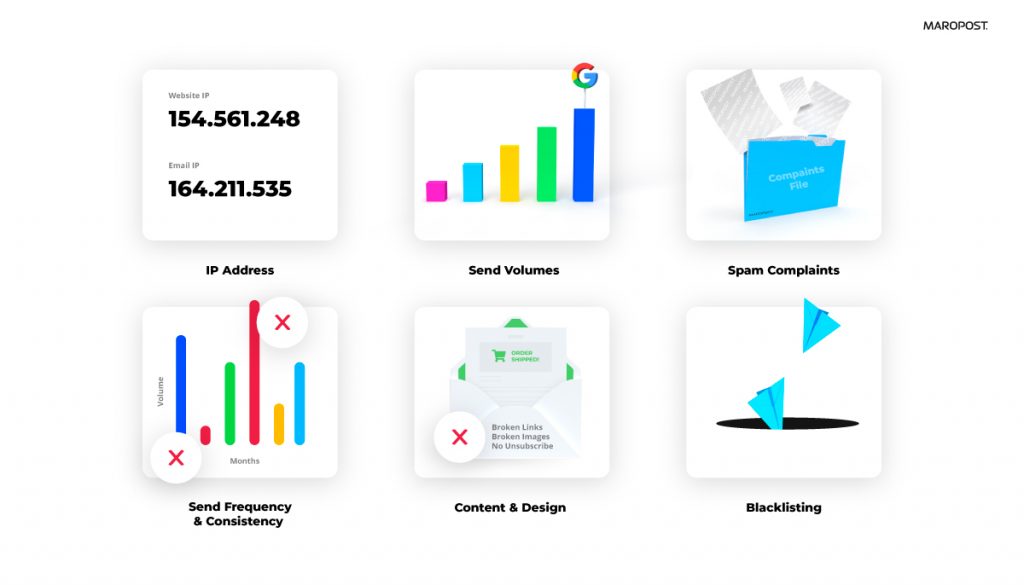Did you know emails generate $38 for every $1 spent? An astounding 3,800% ROI; that makes email marketing a big deal. Imagine sending mail through a courier and it gets to the recipient. Now, imagine the mail was never retrieved from the mailbox, now, that’s an email deliverability issue.
This article will prepare every business and marketer to tackle deliverability issues in their email marketing campaigns.
So, let’s dive right in!
Content Index:
- What is Email Deliverability?
- Why is Email Deliverability Important?
- What is a Good Deliverability Rate?
- Factors That Affect Deliverability
- How to Improve Email Deliverability
What is Email Deliverability?

A simple definition: email deliverability determines where your email will end up — in the inbox, spam folder, or another folder.
Deliverability can be grouped into three parts: Identification, Reputation, and Content. Identification and Reputation are responsible for most of the reasons your email will either end up in the inbox or the spam folder.
Identification asks “are you who you say you are?” While reputation asks “are you trustworthy?” Content on the other hand deals with if your message is relevant and useful to your audience. To have good email deliverability, you must have a positive answer to these questions.
Why is Email Deliverability Important?

59% of respondents in a marketing survey say marketing emails influence their purchase decisions. This shows that email marketing is an incredibly useful tool in your marketing arsenal. So, why is email deliverability important?
Your email deliverability rate goes a long way to determine if your email marketing campaign will be successful or not. Simply put, no matter how great your email marketing strategy is, a poor deliverability rate will undermine your email marketing efforts.
So, you don’t have a great email marketing strategy until your strategy also includes having a good deliverability rate.
What is a Good Deliverability Rate?

95% or higher is considered a good delivery rate by most email providers. A good delivery rate simply tells you that your emails are being received by a recipient’s ISP gateway server, it does not necessarily translate to a good deliverability rate.
A good deliverability rate measures if your emails made it to the inbox vs. ending up in the spam folder. You can’t know this exactly because gateway servers will not tell email senders if emails were blocked (but not bounced) or filtered.
However, you can ensure a good delivery rate first, then invest in email deliverability best practices.
Factors That Affect Deliverability

1. IP Address
Emails are designed to carry the IP (Internet Protocol) address of the sender. Your IP credibility, domain reputation and sender reputation collectively affect your email deliverability.
2. Send Volume
Send volume deals with the number of emails you schedule to send out. Are you a high volume or a low volume sender?
3. Spam Complaints
How many people complained about your email, sent it to the spam folder or unsubscribed A complaint rate of no more than 0.1% is a good indicator that your recipients are wanting what you are sending them, anything higher and the ISPs and Mailbox Providers may think otherwise.
4. List Quality
You can determine the quality of your email list by comparing negative metrics to positive ones. High bounce rates and complaint rates are negative metrics, high open and click rates are positive ones. If the former are low and the latter are high, it is a good indicator that you have a high quality list.
5. Send Frequency and Consistency
The rate at which you send out emails. How many emails do you deploy per week, per month or per campaign? Are you consistent in when and how often you deploy?
6. Content and Design
Is it targeted, relevant, and aesthetically appealing? Your content, which is the message you want to pass across must be useful to your recipients and your design should make it more engaging.
7. Blacklisting
To be blacklisted by an ISP means your emails will get flagged by spam filters and they will not get to the recipients’ inbox or they may be blocked altogether. Blacklisting must be avoided at all cost, by following best practices.
How to Improve Your Email Deliverability

1. Start with your sender reputation
Your sender reputation is tied to the domain and IP from which you send out emails. That is, wherever you use that domain or IP address to send email, your sender reputation will follow.
Each ISP has their own unique scoring system based on their assessment of your reputation. Based on this score, each will automatically determine if your email should go to the inbox, spam folder or if it should be blocked and bounced back.
2. Your IP address
When it comes to your IP (Internet Protocol) address, you should consider two things: your IP reputation and having a dedicated IP address.
Ensure that your email content is always fully compliant with anti-spam laws. You are simply telling spam filters that your IP is valid and trustworthy.
By having a dedicated IP address, you are completely responsible for your own reputation. Your IP reputation cannot be affected by someone else’s activities as in a shared IP address.
3. Invest in creating a clean email list
To start with and very importantly, do not buy email lists. It will hurt your campaign results and reputation in the long run. Instead, invest in creating your own email list. Which means, building it from scratch.
People who want to join your mailing list should do so voluntarily. Also, purge your list once in a while. That is, launch a reengagement campaign and weed out inactive emails.
4. Double Opt-in
Do not try to trick people into subscribing for a newsletter in order to get them on your mailing list. You should follow guiding regulations like the Canadian Anti-Spam Law, the European Union GDP and the CAN-SPAM Act in building your email list.
Double opt-in means that after a potential subscriber has signed up for your emails, you should send a confirmation email as a follow-up to them to confirm their subscription. You must also provide an option to unsubscribe, usually a link in the body of an email.
5. Personalized content
Personalization starts with segmentation. Segment your audience and send targeted and personalized messages to them. Marketers who use segmentation note as much as a 760% increase in revenue.
More so, your recipients are more likely to open a “customized” message than a “made-for-all” message. You will be recording more opens and clicks.
Need to chat about your mobile marketing strategy?
More than 10,000 marketers use Maropost to engage with their prospects and customers through emails, SMS, social media and more. We’re here to help you growing your business!
Chat Now

